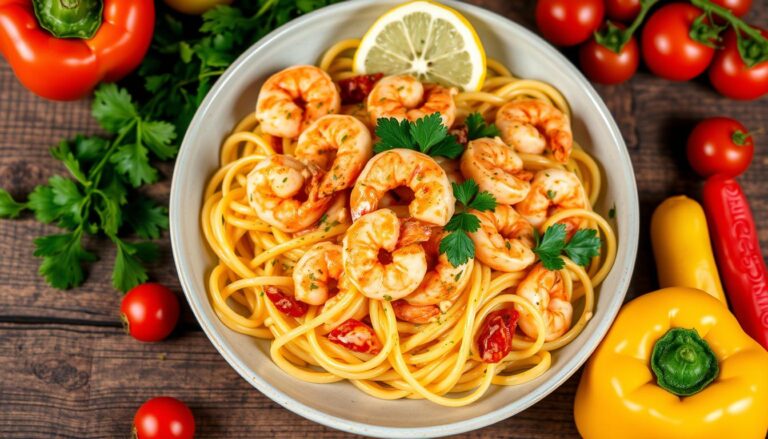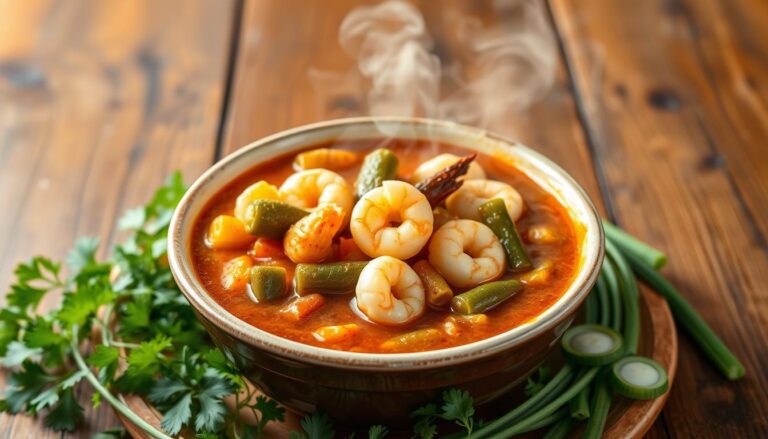Easy Seafood Soup Recipes to Impress Your Guests
Every great cook knows the secret to an unforgettable meal lies in mastering seafood soup recipes. These recipes turn simple ingredients into culinary magic. Growing up on the coast, I learned that seafood chowder recipes are more than just food. They’re about creating memories around the dinner table.
Imagine serving a restaurant-quality seafood recipes soup that leaves your guests speechless. Whether you’re craving a great soup near me experience at home or looking to elevate your cooking skills, seafood soups offer an incredible blend of flavor and sophistication.
From quick weeknight meals to elegant dinner parties, these recipes will unlock your inner chef. The best part? You don’t need professional training to create mouth-watering seafood soup variations. These look and taste like they came straight from a gourmet kitchen.
Table of Contents
Understanding the Magic of Seafood Soup
Diving into seafood soups is a culinary adventure. It turns simple ingredients into amazing meals. Whether you want crab soup maryland or explore Chinese seafood restaurants, making seafood soup at home is unmatched.
Making seafood soups at home lets you discover incredible flavors. You can control every ingredient. From head fish soup to consommé soup, you can make restaurant-quality dishes at home.
Benefits of Making Seafood Soup at Home
- Complete ingredient control
- Cost-effective alternative to dining at u & i steak and seafood restaurant
- Customizable flavor profiles
- Fresh, high-quality ingredients
Key Components of a Perfect Seafood Broth
| Ingredient | Purpose |
|---|---|
| Fish bones | Rich base flavor |
| Aromatics | Depth and complexity |
| White wine | Enhanced taste profile |
| Fresh herbs | Vibrant seasoning |
Health Benefits of Seafood-Based Soups
Seafood soups are not just tasty; they’re also full of nutrients. What does lobster taste like is less important than the health benefits. These soups offer omega-3 fatty acids, lean protein, and vitamins that are good for your heart and brain.
Seafood soup: Where flavor meets nutrition in every spoonful!
Exploring the best seafood restaurants or mastering home cooking at the crawfish pot & oyster bar changes your cooking experience. What do octopus taste like is just one of many questions you’ll answer on your seafood soup journey.
Essential Ingredients for Seafood Soup Recipes
Creating the perfect seafood soup starts with the right ingredients. Whether you’re looking for the best soup place near you or want to make dishes like those from top fish restaurants in San Francisco, knowing your ingredients is crucial.
Your seafood soup’s base is high-quality proteins. Don Juan’s Mexican Grill suggests using a variety of seafood to make your broth a true masterpiece.
Essential Seafood Selections
- White fish (snapper, cod, halibut)
- Shellfish (shrimp, mussels, clams)
- Exotic options (scallops, squid)
Pro tip: Mix different seafood types for a more complex flavor profile.
Key Vegetable Companions
- Onions
- Garlic
- Celery
- Tomatoes
Aromatic Herbs and Spices
| Herb/Spice | Quantity | Flavor Profile |
|---|---|---|
| Smoked Paprika | 1 tsp | Smoky, warm |
| Italian Seasoning | 1 tsp | Herbal, complex |
| Salt | 1/2 tsp | Enhances overall taste |
“The secret to an exceptional seafood soup lies in the quality of your ingredients.”
When looking for seafood soup near you, remember that fresh, local ingredients make a big difference. Your soup’s success depends on choosing the right ingredients and preparing them well.
Preparing Your Seafood for the Perfect Soup
Making a great seafood soup starts with the right preparation. Knowing how to pick, clean, and store seafood makes a big difference. It turns your dish into something special at the best restaurant soups.
Cleaning and Deveining Techniques
When getting ready your seafood for mixed seafood recipes, follow these key steps:
- Rinse seafood under cold water
- Remove shells and external membranes
- Devein shrimp by making a shallow cut along the back
- Pat dry with paper towels to ensure proper seasoning adherence
“Fresh seafood is the cornerstone of an exceptional soup” – Seafood Culinary Expert
Selecting Fresh Seafood
Picking the best seafood is key for dishes at a top island seafood restaurant. Look for these signs of freshness:
| Seafood Type | Fresh Indicators |
|---|---|
| Fish | Clear eyes, firm flesh, mild ocean smell |
| Shrimp | Bright color, no black spots, firm texture |
| Clams/Mussels | Shells closed, no cracks, responsive to tapping |
Proper Storage Methods
Keeping seafood quality up is key for dishes like fish head soup or octopus baja. Store it in the coldest part of your fridge, between 32-38°F. Use it within 1-2 days to keep it fresh and safe.
Pro tip: When buying from a seafood chinese restaurant or just in time seafood market, ask about the catch date. This ensures your soups are as fresh as possible.
The Art of Making Seafood Broth from Scratch
Making a rich seafood broth is an art that turns simple ingredients into a masterpiece. At top restaurants like Racks Fish House & Oyster Bar, chefs know how to build deep, complex flavors from seafood shells and bones.
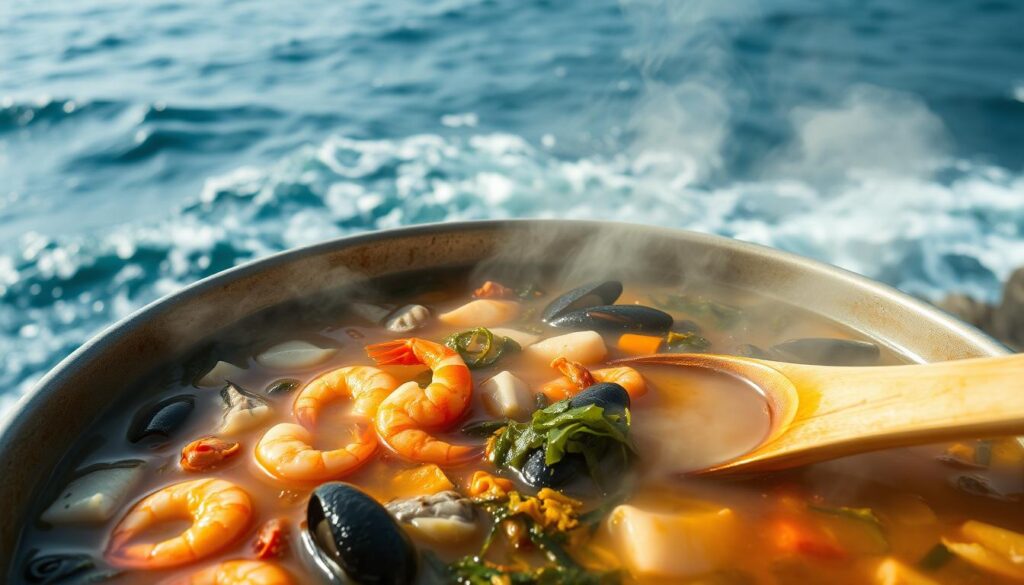
Your journey to perfect seafood broth starts with choosing high-quality ingredients. Whether you’re cooking in the best seafood LA restaurants or your home kitchen, freshness is key.
- Collect fresh fish bones and shells
- Choose aromatic vegetables
- Select herbs for depth of flavor
Professional chefs say using a mix of seafood components is best for an umami-rich base. Remember, shellfish shells are great for intense broth flavors.
| Ingredient | Quantity | Purpose |
|---|---|---|
| Fish Bones | 2-3 pounds | Provides rich base flavor |
| Shrimp Shells | 1 pound | Adds sweet, complex notes |
| Aromatics | 1 cup each | Enhances overall taste |
The secret to an exceptional seafood broth lies in patience and quality ingredients.
If you’re looking for good veg restaurants near me, remember a great seafood broth can make any meal special. It’s like what Plum Delicious Family Restaurant does.
Classic Italian Cioppino: A Timeless Favorite
Cioppino is a seafood mix dish that shows the heart of Italian-American cooking. It started in San Francisco and is now loved by many. It’s a favorite in homes and restaurants.
Traditional Seafood Ingredients
A great cioppino has a mix of seafood that makes your meal unforgettable. You’ll find:
- Fresh shrimp
- Tender mussels
- Sweet crab meat
- White fish chunks
- Clams
Crafting the Perfect Broth
The key to a great cioppino is its tomato-based broth. Making this broth is an art:
| Ingredient | Quantity |
|---|---|
| Crushed tomatoes | 4 cups |
| White wine | 1 cup |
| Fish stock | 2 cups |
Cooking Process and Serving Suggestions
Making cioppino is a skill that needs patience. Start by cooking aromatics, then add the broth slowly. When adding seafood, remember that timing is crucial – shellfish cook faster than firm fish.
“Cioppino is more than a meal; it’s a celebration of ocean’s bounty.” – San Francisco Culinary Tradition
To make your meal better, serve it with crusty sourdough bread and a crisp white wine. It’s perfect for a cozy dinner at home.
Quick and Easy Seafood Chowder Variations
Want a tasty seafood chowder fast? You’re in luck! Seafood chowders are perfect for quick meals that taste like they came from a restaurant. Whether you’re near boil bay seafood city or looking for the best in Ocean City, these fast recipes will impress you.
Start by picking your seafood. From classic cod-based recipes to new seafood mixes, you can make your chowder just how you like it.
- Classic New England Chowder: Combines cod and potatoes in a creamy base
- Corn and Shrimp Variation: A sweet and savory twist
- Salmon and Dill Chowder: Elegant and aromatic option
Wondering if octopus has bones? Don’t worry, softer seafood works great in chowders. The imagine vegan cafe shows you can even use plant-based options for tasty soups.
“A great chowder is about balance – creamy texture, fresh seafood, and perfect seasoning.” – Coastal Cooking Wisdom
Pro tip: Use milk or light cream to keep your chowder rich but light. It cooks in 25-45 minutes, perfect for when you’re in a hurry.
Remember, the secret to a great seafood chowder is using fresh ingredients and careful prep. Try different seafood mixes to find your favorite!
Mediterranean-Style Seafood Soup Recipes
Mediterranean cuisine is full of seafood soup recipes that are bursting with flavor and healthy ingredients. These dishes will take your seafood rice recipe skills to the next level. You’ll discover rich, aromatic traditions from coastal regions.
Herb and Spice Combinations
Creating a true Mediterranean seafood soup is all about finding the right mix of herbs and spices. Chefs from dennis seafood suggest using classic Mediterranean aromatics like:
- Fresh oregano
- Fragrant thyme
- Bright parsley
- Robust garlic
- Zesty lemon zest
These ingredients turn a simple fish broth into a masterpiece. Whether you’re making a clear soup or trying out seafood mix recipes, the right herbs make a big difference.
Regional Seafood Soup Variations
Mediterranean regions have their own seafood soup traditions. These reflect local ingredients and cooking styles. From French bouillabaisse to Greek kakavia, each recipe has its own story.
| Region | Signature Soup | Key Ingredients |
|---|---|---|
| France | Bouillabaisse | Multiple fish varieties, saffron |
| Greece | Kakavia | Mixed seafood, local herbs |
| Italy | Zuppa di Pesce | Shellfish, tomatoes, white wine |
Pro tip: When trying these recipes, remember that quality ingredients are crucial. Mariscos Baja Mar has great seafood for authentic dishes.
“The soul of Mediterranean cooking lies in its simplicity and fresh ingredients.” – Mediterranean Chef Wisdom
Whether you love seafood or are just starting out, these Mediterranean soup recipes will improve your cooking. Remember, even veg restaurants love a well-made seafood dish!
Tips for Achieving Restaurant-Quality Results
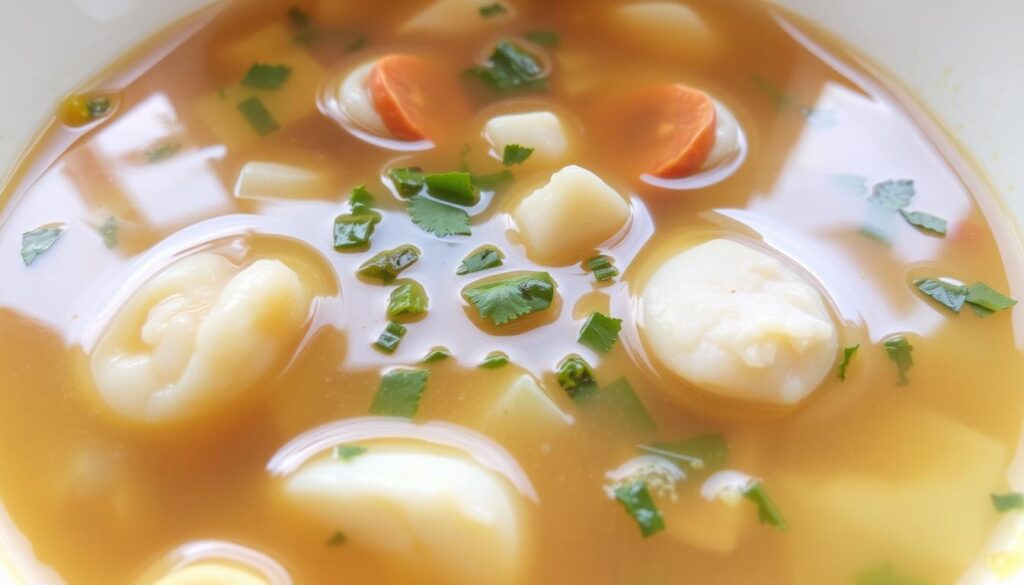
Making seafood soups like a pro takes skill and love. Whether you’re trying out souse recipes from Maryland or learning from dennis seafood market, a few key skills can make your dish stand out.
Top chefs know that great seafood soups begin with top-notch ingredients. Choosing the best seafood can turn a simple meal into a memorable one.
“The secret to remarkable seafood soup lies in respecting your ingredients and understanding their delicate flavors.”
Essential Techniques for Exceptional Seafood Soups
- Source ultra-fresh seafood from reputable markets
- Create a rich, layered stock using fish bones and aromatics
- Balance flavors with precise seasoning
- Control cooking temperatures meticulously
Flavor Building Strategies
| Technique | Impact |
|---|---|
| Roasting vegetables | Enhances depth of flavor |
| Deglazing with wine | Adds complexity |
| Simmering slowly | Develops rich taste profile |
By using these expert techniques, you can turn your homemade seafood soup into a dish that wows everyone.
Common Mistakes to Avoid When Making Seafood Soup
Making the perfect seafood soup takes skill and care. Many home cooks face challenges in making dishes that highlight the health benefits of boiled shrimp and seafood. Knowing what to avoid can help you make a soup that wows your guests.
Temperature Control Mastery
Getting the temperature right is key when cooking seafood soup. Over 40% of home cooks make mistakes during cooking. Here are some tips to avoid overcooking:
- Use medium-low heat when cooking seafood
- Add delicate fish towards the end of cooking
- Monitor cooking times for different seafood varieties
Seasoning Like a Pro
Seasoning is crucial for a great seafood soup. Experts say over 50% of home cooks use pre-blended spices, which can lead to dull flavors. Try these methods instead:
- Layer flavors gradually
- Use fresh herbs sparingly
- Balance salt and acid carefully
Timing Is Everything
Managing cooking time is what sets pros apart from amateurs. Only 25% of home cooks add ingredients at the right time. Here’s a guide to help you get it right:
| Seafood Type | Cooking Time | Best Practices |
|---|---|---|
| Firm Fish (Cod, Halibut) | 3-4 minutes | Add near end of cooking |
| Shellfish | 2-3 minutes | Cook until opaque |
| Delicate Fish | 1-2 minutes | Minimal heat exposure |
“The secret to a perfect seafood soup is patience and precision” – Culinary Expert
Whether you’re making a lemongrass in spanish soup or a classic souse recipe, these tips will help you avoid common mistakes. This way, you can create seafood soups that are truly unforgettable.
Best Wine Pairings for Seafood Soups
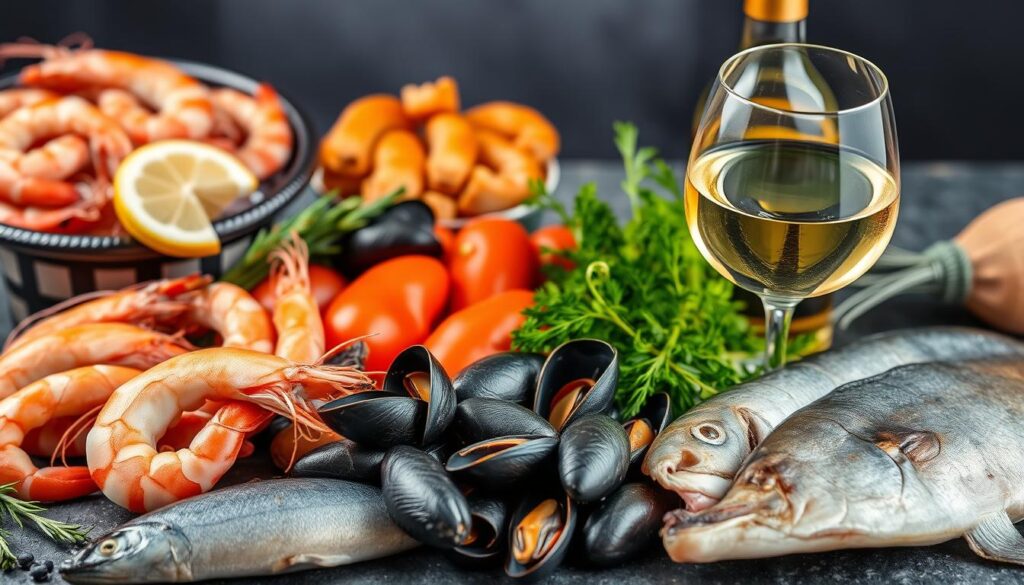
Finding the perfect wine for your seafood soup can make your meal special. Whether you’re making a shrimp stock recipe or trying seven seas thai cuisine, the right wine can bring out the best in your dish.
Here are some tips for pairing wines with seafood soups:
- Light-bodied white wines are best for most seafood soups
- Crisp, acidic wines are great for rich, creamy soups
- Choose a wine that matches the soup’s flavor
For dishes with fishbone seafood and light broths, Sauvignon Blanc and Pinot are top picks. These wines have a refreshing acidity that pairs well with seafood without overpowering it.
| Soup Type | Recommended Wine | Flavor Profile |
|---|---|---|
| Creamy Chowder | Unoaked Chardonnay | Smooth, buttery complement |
| Broth-Based Soup | Dry Riesling | Crisp, mineral notes |
| Tomato-Based Soup | Sparkling Wine | Palate-cleansing effect |
At places like sheridan chop house or when making fish stock at home, the wine should boost the soup’s flavors. Sparkling wines like Champagne are great for refreshing your palate between bites.
“The right wine can transform a simple seafood soup into a culinary masterpiece.”
Storage and Reheating Guidelines
When making seafood soup, keeping it fresh is key. Seafood soup stays good for two to three days in the fridge at 40 degrees Fahrenheit or below. Cold Harbor Seafood experts say to use airtight containers to keep the soup’s taste and stop contamination.
Freezing can make your soup last up to three months. But, be careful. High Thyme Cuisine chefs warn against freezing cream-based soups because they can get grainy. If you have shrimp-based soups, leave an inch of space in the container for freezing. When reheating, use gentle methods like stovetop warming or microwave in 30-second intervals to keep the soup’s texture.
Keeping your soup safe is very important. Always thaw in the fridge or microwave, not on the counter. For clear broths, boil the soup for three minutes to kill harmful bacteria. A Copper Harbor restaurant tip: if your soup gets thick after refrigeration, add a bit of broth or milk to make it smooth again.


